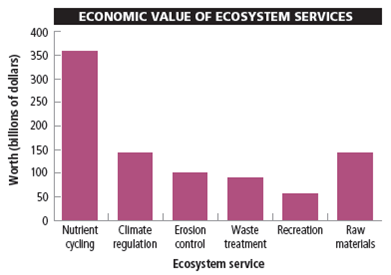
Environmental Science 15th Edition by Scott Spoolman,Tyler Miller
Edition 15ISBN: 978-1305090446
Environmental Science 15th Edition by Scott Spoolman,Tyler Miller
Edition 15ISBN: 978-1305090446 Exercise 14
PUTTING A PRICE TAG ON NATURE'S ECOSYSTEM SERVICES
Currently, forests and other ecosystems are valued mostly for their economic services (Figure 9.4, right). Ecologists and ecological economists call for us to include in such valuations the estimated monetary value of the ecosystem services provided by forests (Figure 9.A). This is a way to implement the full-cost pricing principle of sustainability.
In 1997, a team of ecologists, economists, and geographers, led by ecological economist Robert Costanza, estimated the monetary worth of 17 ecosystem services provided by the earth's ecosystems (including, for example, pollination and regulation of atmospheric temperatures) to be at least $33.2 trillion per year. The researchers also estimated that the amount of money we would need to put into a savings account to earn that amount of interest income would be at least $500 trillion-an average of more than $70,400 for every person on the earth in 2014.
According to Costanza's study, the world's forests alone provide us with ecosystem services worth at least $4.7 trillion per year-hundreds of times more than their economic value in terms of lumber, paper, and other wood products (Figure 9.A). The researchers pointed out that their estimates were very conservative.
In 2002, Costanza and other researchers estimated that preserving ecosystems in a global network of nature reserves occupying 15% of the earth's land surface and 30% of the ocean would provide $4.4 trillion to $5.2 trillion worth of ecosystem services-about 100 times the economic value of converting those systems to human uses.
If the estimates from these studies are close to correct, we can draw three important conclusions: (1) the earth's ecosystem services are essential for all humans and their economies; (2) the economic value of these services is huge; and (3) these ecosystem services will be an ongoing source of ecological income, as long as they are used sustainably.
Critical Thinking
Some analysts believe that we should not try to put economic values on the world's irreplaceable ecosystem services because their value is infinite. Do you agree with this view? Explain. What is the alternative?

FIGURE 9.A Estimates of the annual global economic values of some ecosystem services provided by forests, compared to the value of the raw materials they produce (in billions of dollars).
Compiled by the authors using data from Robert Costanza.
Currently, forests and other ecosystems are valued mostly for their economic services (Figure 9.4, right). Ecologists and ecological economists call for us to include in such valuations the estimated monetary value of the ecosystem services provided by forests (Figure 9.A). This is a way to implement the full-cost pricing principle of sustainability.
In 1997, a team of ecologists, economists, and geographers, led by ecological economist Robert Costanza, estimated the monetary worth of 17 ecosystem services provided by the earth's ecosystems (including, for example, pollination and regulation of atmospheric temperatures) to be at least $33.2 trillion per year. The researchers also estimated that the amount of money we would need to put into a savings account to earn that amount of interest income would be at least $500 trillion-an average of more than $70,400 for every person on the earth in 2014.
According to Costanza's study, the world's forests alone provide us with ecosystem services worth at least $4.7 trillion per year-hundreds of times more than their economic value in terms of lumber, paper, and other wood products (Figure 9.A). The researchers pointed out that their estimates were very conservative.
In 2002, Costanza and other researchers estimated that preserving ecosystems in a global network of nature reserves occupying 15% of the earth's land surface and 30% of the ocean would provide $4.4 trillion to $5.2 trillion worth of ecosystem services-about 100 times the economic value of converting those systems to human uses.
If the estimates from these studies are close to correct, we can draw three important conclusions: (1) the earth's ecosystem services are essential for all humans and their economies; (2) the economic value of these services is huge; and (3) these ecosystem services will be an ongoing source of ecological income, as long as they are used sustainably.
Critical Thinking
Some analysts believe that we should not try to put economic values on the world's irreplaceable ecosystem services because their value is infinite. Do you agree with this view? Explain. What is the alternative?

FIGURE 9.A Estimates of the annual global economic values of some ecosystem services provided by forests, compared to the value of the raw materials they produce (in billions of dollars).
Compiled by the authors using data from Robert Costanza.
Explanation
I completely agree with this view.
It is...
Environmental Science 15th Edition by Scott Spoolman,Tyler Miller
Why don’t you like this exercise?
Other Minimum 8 character and maximum 255 character
Character 255



